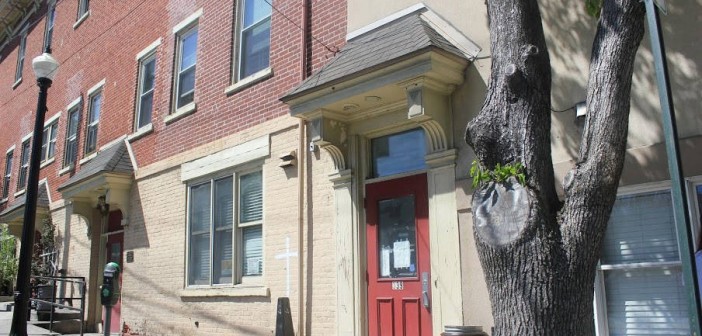To afford a two-bedroom apartment at the median rental rate in Bethlehem, a person would have to work 89 hours a week at minimum wage or earn $18.69 an hour, according to a 2015 study by the Department of Housing and Urban Development.
Throw the unaffordable cost of food, a lack of educational opportunities and a big university into the mix, and it’s no wonder that South Bethlehem is considered the poorer side of town.
Throughout the latter half of the 19th and much of the 20th centuries, Bethlehem’s steel and textile mills brought in waves of immigrants from around the world who came here to escape political and economic problems in their homelands. Most had not received more than a high school education, and Bethlehem was a place that boasted opportunities for manual labor.
The steel mill had its last cast in the blast furnace in 1995, and poverty rose as a result of its downfall. Since then, it has become harder for South Side residents to keep pace with rising costs of living.
Free and reduced lunch statistics are often the best way to calculate the magnitude of poverty in the area. For a student to qualify for reduced lunch, a family of four must earn less than $45,000 a year, and that number drops to $31,000 a year to qualify for free lunch.
In the three schools surrounding Lehigh — Broughal Middle School, Donegan Elementary School and Fountain Hill Elementary School — 89 percent of students are eligible for free or reduced lunch at Broughal, 92 percent are eligible at Donegan and 79 percent are eligible at Fountain Hill, according to the United Way’s website. This means nearly 1,400 children in South Bethlehem come from low income families.
Kimberley Carrell-Smith, a Lehigh history professor and a longtime South Bethlehem resident, is dedicated to analyzing the “why” and “how” behind poverty instead of stating the obvious fact that poverty exists.
“There is this tendency of Lehigh students to come from backgrounds where they are used to living in a pretty homogenous, highly-educated community — upper middle class or perhaps solid middle class — where they have this idea that people are more aspirational from where they come from (compared to the residents of South Bethlehem),” Carrell-Smith said.
According to the American Community Survey of 2014, approximately one in four adults living in South Bethlehem does not have a high school degree. However, residents of the South Side are far from unmotivated. The majority of adults are working but still live at or below the poverty line for a number of reasons, most commonly because wages are relatively low and because a lack of full-time jobs forces individuals to accept part-time positions.
In many cases, a lack of education isn’t to blame for the high poverty rates. As the data from the survey show, seven out of 11 census blocks in South Bethlehem include more college degrees than the Lehigh census block, proving that more people have advanced degrees in the neighborhoods near campus than Lehigh students do.
“It’s important to remember that poverty is systemic,” Carrell-Smith said. “It’s not just something that happens because people behave in a certain way or don’t conform to social norms.”
Alan Jennings, the executive director of the Community Action Committee of the Lehigh Valley, believes Lehigh has contributed to the poverty in South Bethlehem. Perhaps most concretely is the way in which students are a deterrent to property investment in the neighborhood.
“Who wants to buy a house next to rowdy college students?” Jennings asked. “And if you already have a house next to rowdy college students, who is going to put money into that house when you know you’re not going to sell the house to someone who can afford what you paid for it?”
Jennings said students who grew up in wealthy neighborhoods come to Lehigh and don’t respect the relatively low-quality off-campus houses. The presence of these students simultaneously diminishes the desirability of the properties while also inflating the market because of how much students are willing to pay.
Houses on East Fifth Street are being rented for up to $750 a month per person, a price landlords would not be able to charge low-income families. Jennings said this destroys the possibility of transforming South Bethlehem into a desirable family neighborhood. Families, unlike investors, care about what their houses look like and would be willing to take out the trash, paint the façade and fix structural damages.
Jennings, however, is also confident the university can reverse many of the problems it has caused. In a document he sent to President John Simon, Jennings outlined the importance of Lehigh intervening in the housing market by strategically purchasing the worst houses in the neighborhood, fixing them up and then putting them back on the market for owner occupancy.
Although it may seem like an unconventional plan, the hope is these houses will then raise the property values of neighboring houses. It would give Lehigh the opportunity to capitalize on the phenomenon that the nicest house on the block raises the value of all the other houses. These property renovations also have the potential to pressure nearby landlords to improve the appearance of the houses they own.
Kate Cohen has a few ideas about how Lehigh students specifically can strengthen their community outreach efforts. Cohen is the director of development and communications at New Bethany Ministries, an organization with nine different programs that serve to address the issues of the hungry, homeless, poor and mentally ill throughout the Lehigh Valley and to create opportunities for a secure future for its thousands of clients.
Cohen said there are issues that need to be addressed at the state level before poverty rates can ever truly be lowered, such as the scarcity of affordable housing, the insufficient minimum wage and the unjust criminalization of homelessness and loitering. She also believes, however, in the power Lehigh students can have and thinks the students’ approach must include three essential aspects: engagement with the community, understanding of the experiences of those that New Bethany serves, and education of themselves and others on the reality of hunger and homelessness.
“You get to college, and you get stuck in this silo, and being able to come outside of that and understand the systemic problems that surround you is a huge part of what we (at New Bethany) do,” Cohen said.
Cohen and her colleagues are continually trying to break down stereotypes about homeless people and promote programs that raise community consciousness.
As for immediate steps Lehigh students can take, however, Cohen is always appreciative of donations in any form, especially food. Since New Bethany’s Mollard Hospitality Center serves two free meals a day Monday through Friday, including all major holidays, nearly $70,000 is spent on food every year. In 2015, they served 69,516 meals to 2,080 different individuals.
“I think it’s baffling that in a society that boasts excess, there are so many people that don’t have enough,” Cohen said. “It’s upsetting, and it’s heartbreaking, and it’s frustrating.”
And although there’s clearly work that still needs to be done, Carrell-Smith has noted the ways Lehigh students have contributed positively to the community. By partnering with community schools to create academic and after-school programs, Lehigh students have given children resources that support families holistically. Through programs facilitated by the Community Service Office such as America Reads and America Counts, Lehigh students help to raise reading and math rates among South Bethlehem youth, which consequently results in increased graduation rates.
Carrell-Smith said there’s just one more piece to the puzzle: Talk to people. It’s something that can be achieved through volunteering at New Bethany, tutoring children at Broughal or interacting with off-campus neighbors to establish a peaceful dynamic that increases the quality of life for everyone involved.
“Once you see your neighbor as a person,” Carrell-Smith said, “it’s really hard to point fingers or look down your nose at people and blame them.”






Comment policy
Comments posted to The Brown and White website are reviewed by a moderator before being approved. Incendiary speech or harassing language, including comments targeted at individuals, may be deemed unacceptable and not published. Spam and other soliciting will also be declined.
The Brown and White also reserves the right to not publish entirely anonymous comments.
3 Comments
Alan Jennings, there’s a name I haven’t seen in a while. I’ll preface all this by saying that I am a landlord myself. I’m also a resident of a city I happen to like, and I don’t enjoy seeing it damaged by irresponsible, greed-driven student-housing practices.
The thing is that this is a problem everywhere there’s a university, at this point, and it’s to do with the irresponsibility of the universities themselves: you can admit as many students as your classrooms will hold and let someone else bother with the housing. And the local housing activists are altogether too polite. Ways of solving the problem and returning responsibility for Lehigh’s housing and party overflow to Lehigh:
1. Rent control. A greed-reduction measure when landlords can’t manage to control themselves, it permits landlords to make a modest profit, but not to gouge and take advantage of the availability of student loans and wealthy student parents. It is in fact possible to make money — quite good money — as a landlord without screwing people to the wall and extracting that last dollar. You won’t make *gobbets* of money, but you will do all right, and you’ll avoid damaging the neighborhood in the meantime.
2. Voucher laws. These require landlords to accept housing vouchers; landlords may not post notices such as “no Section 8”.
3. Zoning. Lots to work with here: limit the rental density in a given area; limit the number of unrelated persons who can share a dwelling; require new developments to reserve units for low-income tenants.
4. Enforcement of equal housing laws. Especially in combination with rent control and voucher laws, makes it extremely expensive for landlords to discriminate against poor POC and “save” properties for college students.
5. Enforcement of housing codes. Landlording’s less fun when you actually have to take care of the property; weeds out the baddies.
6. Enforcement of noise and nuisance laws. Rude house party? Your parents will be mad when they get the bill from the cops.
7. HUD rent-to-own programs: in conjunction with zoning, restores neighborhoods to owner-occupied residential areas.
It’s not a problem that Lehigh has nearly twice as many students as it did when I went there; good for them for managing that. But if they want all these students, then rather than sit all over South Bethlehem with a big well-upholstered ass, not caring who they might smother in the process, they’re entirely able to build more student apartment towers or quaint fieldstone villages or what have you on that lovely luscious green campus. I’m sure someone sells Quik-Gro ivy to decorate the outsides with. But to force that Alan & co. will have to articulate it as a central issue locally and sit in government for at least a few years.
It can happen. It’s happened elsewhere. Personally, I think universities that behave this way should be the target of many a lawsuit. It’s impossible to run a low-income housing program in a central location if the local college or university insists on inviting more and more deep-pocketed students while refusing to house them itself. I wouldn’t mind seeing loss of tax-exempt status until the university can see its way clear to being a good neighbor, either. If they aren’t going to contribute, they can at least refrain from doing harm.
Lehigh didn’t cause any of this, except by possibly providing managers at Beth Steel. These managers caved in to the union demands for $35 an hour wages ( in 1965 dollars!) and age 50 retirement.
That lasted while the US had a monopoly on steel production and could set the price. Then when more modern and labor efficient German and Japanese steel plants (we had bombed ther old ones into oblivion in WW2) came online in the 1970s, they could no longer compete due to labor costs and went bankrupt.
Then the Eastern European extraction blue collar workers ( look at the names of the local churches) moved away and poor Hispanics flowed in.
That’s the background of the current situation.
That’s part of the history, Gary. I think you left out the part where the managers were too busy drinking and golfing to admit that the new European, South American, and Asian plants were producing steel of better quality with those new furnaces — not with labor efficiency, but with modern equipment and better-educated labor. I actually got to see one of those plants in operation. Different planet from Beth Steel, which was a very sad old dinosaur. Managers refused to modernize and compete on quality, which is why as late as the mid-80s you could wake up in South Bethlehem and smell the sulfur coming through the closed windows. There was a belated stab at a boutique division for high-quality steel, but it was much too little much too late.
In any case. I’ll break down the rest for you real simple.
Poor people have to live somewhere too. Doesn’t matter if they’re Polish Catholic or Portuguese or Latino or poor white Penna Dutch.
And when a university charging $50K a year tuition invites more students than it can house itself, they have to go somewhere. Where do they go? All around the university.
The landlords are not stupid. They understand that a lovely 19-year-old with skis on top of the late-model VW has parents who will pay and pay and pay. So they jack the rent sky-high, and neither the 19-yo nor the parents have the sense to say “Are you out of your mind?” They say, “Oh, okay,” and they write the checks or do the EFT or what have you.
Now the poor people have noplace in this area to live. Even if they manage to hang on to an apartment, scrape together the rent, now they’ve got screaming drunk rich children in the neighborhood waking them up when they’re trying to get some sleep so they can work the next day, because yes, Saturday is also a work day, and waking up their children, and turning the place into a beer-sodden mess.
That is a problem. These are not garbage people you can simply throw away. They’re actual people. They have to have reasonable places to live in, and reasonable schools for their kids to go to, and part of the job of a local government is to ensure that housing remains affordable in the area. One of the problems, though, that a local government has when a university is in its midst is that the university not only causes housing and policing problems, but is tax-exempt.
It is depressing that you need this lesson in basic civility, Gary, but there it is.
What I find newly depressing at Lehigh, though, is this. Thirty years ago you had openly selfish Lehigh students. Real selfish assholes, your future captains of industry, future hedge fund types. Had no problem ordering around Lehigh’s 16 black and Latino students on the assumption that they were maids, because that’s what black and Latino people are for, are they not? These kids didn’t give a good goddamn about anyone. Was it a good thing that they treated the already-poor people in S. Bethlehem the way they did, no, but at least they were honest.
Now the language of social justice has come to Lehigh. Now we have rich kids earnestly sympathizing with the poor while kicking them right in the nuts. And I think they genuinely believe that the talk alone is something. It’s something in the sense that it makes them feel good about themselves and their friends, I suppose, but — well, have a look at this program written up here just recently that effectively turns poor people in So. Bethlehem into a janitorial staff to clean up after Lehigh kids. And they’re proud of this. Honest to god. A whole campus, right up the hill, where maybe some of these people could learn something that might help them get better jobs and benefit from these famous Lehigh networks, and are our socially-conscious people going to do anything with that? Well no, but here’s a broom and a few bucks an hour to clean up after us, at least till the money from that program’s gone.
I wonder if it’s still true that you really need to leave Lehigh’s campus to help in any useful way. I used to volunteer with the local Volunteers of America — literacy stuff. I remember this one woman: she must’ve been in her late 20s or so, couldn’t read. Her husband liked it that way, but she was embarrassed in front of her 8-year-old. So I taught her. She was a lot smarter than me, had to help me out a lot. But she could read some by the time we were done, well enough to get better on her own if she practiced. The literacy market is just now catching up with some of the problems we saw then: very easy readers for adults, where were they? It was all children’s books, you couldn’t read anything about an adult life. And the pedagogical stuff: adults have much more experience with learning than children do, and you can use that, you don’t need to do it with bright colors and songs, which wind up feeling demeaning.
It would help immensely to start from the premise that these are people.